Last updated on March 14, 2024
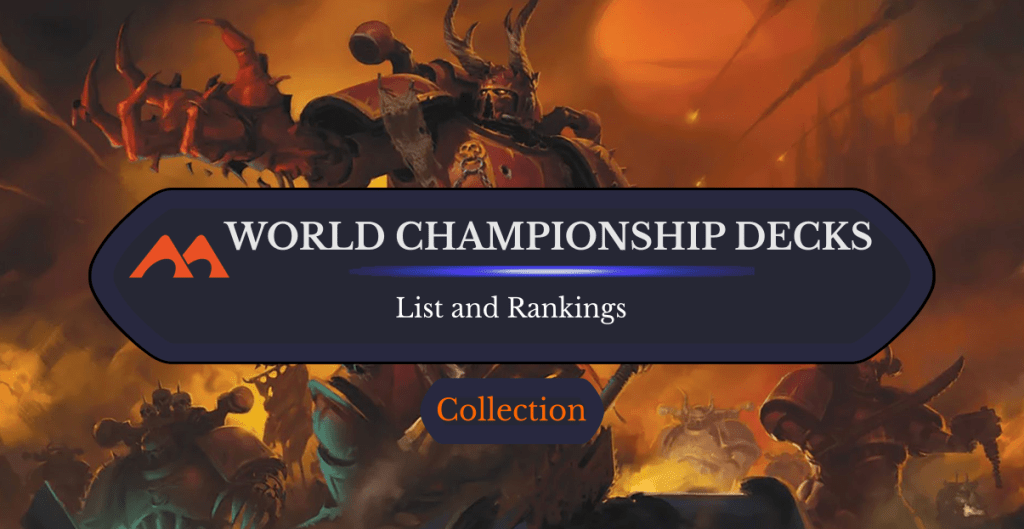
Aspiring Champion | Illustration by Miguel Sacristan
Across time, a few individuals stand out from the masses. Those who prove they can harness the powers of the multiverse, become undefeatable gods of Magic.
Wizards have set their names in stone and cardboard, allowing future generations to honor and revere those planeswalkers who came before them. These World Champions’ decks were printed as promotional products each year after the Pro Tour to give regular folk a taste of real competitive Magic.
What’s in the World Championship Decks, and how do they stack up against each other?
What Were the World Championship Decks?
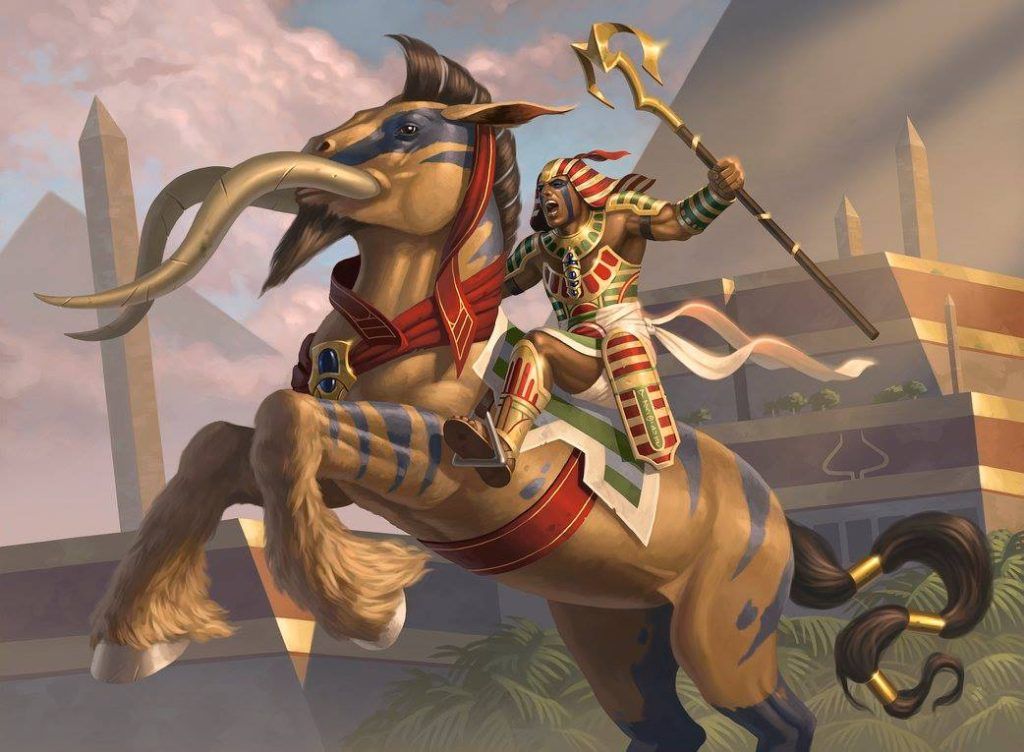

Ahn-Crop Champion | Illustration by Craig J Spearing
The World Championship Decks were a series of pre-packaged decks produced by Wizards from 1997 to 2004. Each year, four of the top-ranked decks used during the World Championships would be reprinted in their entirety, including their 15-card sideboards.
What Was in World Championship Decks?
Each World Championship Deck included the 60-card mainboard and 15-card sideboard used by that pro player during the Championship. The cards were reprinted with a gold border, a unique promotional card back, and a golden signature from their respective pilot. Each deck also contained 12 blank proxy cards to be used as the player saw fit. (I hope you didn’t draw all over yours, like me! These relics are one of my favorite artifacts from Magic’s early history, and I rarely see near-mint copies around).
World Championship Decks List and Rankings
A deck series focused on the best lists in the meta makes for a super powerful product, but some decks stood above the rest. Rather than rank the individual decks against each other, I compare each year’s releases. Since the decks come from different metas, they aren’t necessarily intended to be played against each other. Instead, a “good” World Championships Deck year will be fairly representative of the competitive scene of its day. It’ll also play tight match-ups against its contemporaries.
#8. 2004
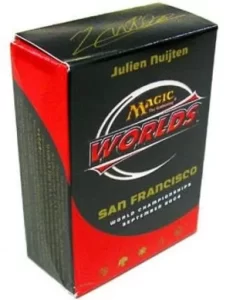

15-year-old Julien Nuijten swept the field of Affinity decks with a Selesnya Astral Slide deck. The youngest Magic World Champion ever, Nuijten’s deck goes heavy on artifact hate, trading against Arcbound Ravagers with Viridian Shamans. Building to the meta paid off for Nuijten, but the Affinity decks weren’t helpless by any means.
Aeo Paquette and Manuel Bevand both brought artifact decks this year.

Paquette’s deck is a more traditional Affinity build with the newest Arcbound creatures.
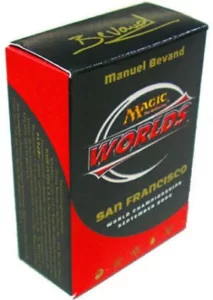

Bevand’s deck is focused more on its Krark-Clan Ironworks and Myr Incubator combo.

With all this Affinity swimming around the format, Gabriel Nassif’s Azorius control deck plays a delicate balance between affinity-hate and responses to the affinity-hate decks. Nassif’s deck slows the game until its opponent runs out of steam, then uses Exalted Angel and Eternal Dragon to clean up.
While this is the most recent and, by the law of power creep, most powerful of the World Championship Decks series, 2004’s Pro Tour lacked any real diversity in decks and tactics.
#7. 2003
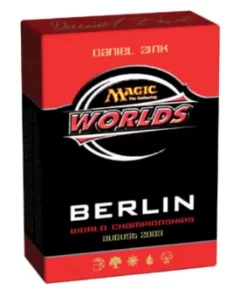

2002’s Judgement saw the release of some powerful cards, but it wouldn’t be until 2003 that Daniel Zink’s Mirari’s Wake deck would reign supreme. Zink’s “Wake” deck only comes online once that enchantment hits the field, but once it does, sheesh. The extra mana means this deck plays more spells and draws more cards before crushing its foes with Decree of Justice.
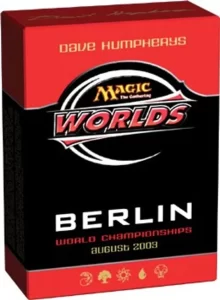

Semifinalist Dave Humpherys brought a Simic madness deck to the tournament, and it paid off. Basking Rootwalla and Arrogant Wurm hit the field at a discount when discarded to Wild Mongrel. Putting Wonder directly into the graveyard grants surprise evasion to those creatures, all for zero mana!
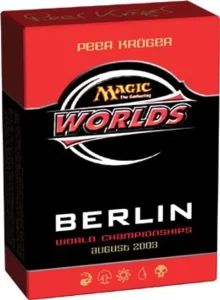

Peer Kroger’s Rakdos reanimator deck uses classics like Buried Alive and Entomb to put threats Visara the Dreadful and Symbiotic Wurm into the graveyard, then Zombify to bring them to the field for value.
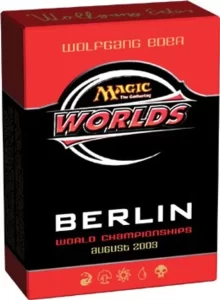

Finally, Wolfgang Eder’s goblin tribal deck looks suspiciously similar to the goblin half of Duel Decks: Elves vs. Goblins, but it runs an important Patriarch's Bidding to survive board wipes and removal. The reanimation means you can use Skirk Prospector freely and without worry that you’ve compromised on your board presence.
#6. 2002
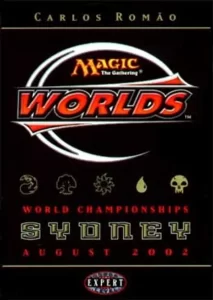

Carlos Romao’s Psychatog deck defined the 2002 World Championship. It slows down opponents in the typical fashion before casting Upheaval and Psychatog in the same turn, then swings with a huge creature on the following turn. It’s such a fragile combo, but Romao’s control elements kept it safe and ultimately clinched the victory.
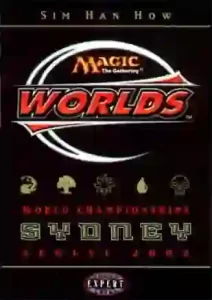

It’s no surprise Romao’s control deck exceeded in 2002, as the rest of this year’s World Championship decks are all aggro. Sim Han How’s deck uses cheap aggressive creatures or swaps to an Opposition combo to defend itself.
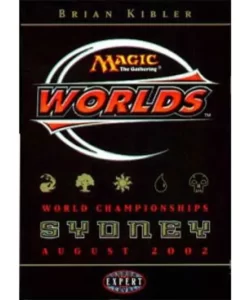

Brian Kibler’s “Red zone 2k2” deck wants to put upwards of 30 creatures on the board and turn those suckers sideways.
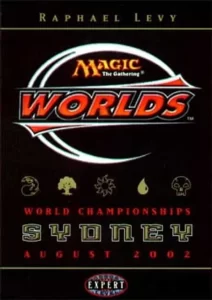

Raphael Levy’s aggro deck starts small but picks up speed once it reaches threshold and once those Nimble Mongooses come online.
#5. 1999
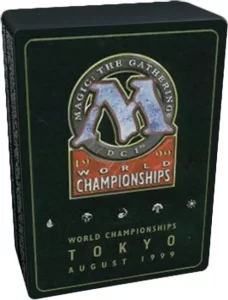

Kai Budde won the 1999 World Championship with 30 artifacts and some “huge” creatures in the form of Masticore and Covetous Dragon. The deck’s Wildfire hardly slows it down with access to so many mana rocks, and a Karn, Silver Golem acts as a back-up win condition.
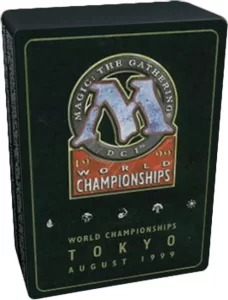

Finalist Mark Le Pine’s “Sped Red” deck quickly floods the board with little creatures, then starts blowing up lands to lock those creatures on the field. Le Pine’s classic Red Deck Wins strategy pays off in this meta.
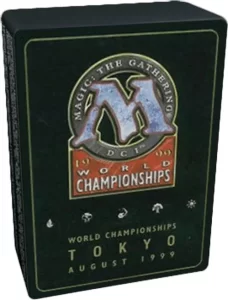

Jakub Slemr made his second appearance in the World Championship Decks with a mono-black control deck that focuses on discard effects from Ravenous Rats and Duress and on using Phyrexian Negator as a damage source.
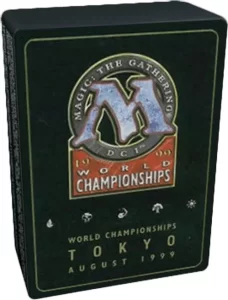

A good indicator for a format’s health is whether or not a straight-up stompy deck is successful, and Matt Linde’s army of Albino Trolls, Pouncing Jaguars fits the bill. Supported by Rancors and Giant Growths, this deck hits the field, hits your opponent, and doesn’t stop. Linde’s Cursed Scroll cleans up as the deck starts to run out of steam.
#4. 2001
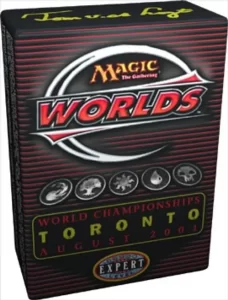

Van de Logt would return to win the World Championship in 2001 with his red and black aggro deck. Plague Spitter and Flametongue Kavu keep the board clear for Skizziks to swing for five or more damage at once.
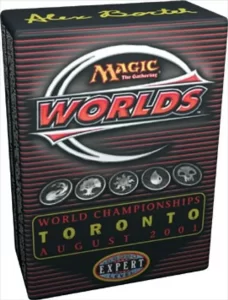

Alex Borteh’s mono blue merfolk deck works like any contemporary tribal deck with a twist of Opposition and Static Orb thrown in to stop its opponents in their tracks. Being mono-colored, this deck’s sideboard includes many great color-hosing spells and really rocks in this meta.
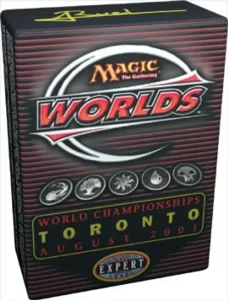

Antoine Ruel’s “Nether, Go” deck is a Grixis take on the “Draw, Go” decks of the day, except it focuses on the consistency of Nether Spirit to always have access to a creature.
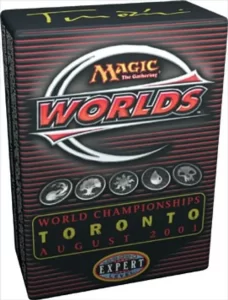

It plays a close matchup against Jan Tomcani’s “Fires” deck. “Fires” takes its name from Fires of Yavimaya, which the deck rushes to play so it can surprise opponents with a hasted Spiritmonger or Kavu Chameleon.
#3. 2000

At the turn of the century, Jon Finkel’s mono-blue artifacts deck reigned supreme. Reminiscent of Kai Budde’s ‘99 deck, Finkel ramps into “big” threats like Masticore, but Phyrexian Colossus is the real beater. Tinkering it into play is a nasty combo, and rightfully won Finkel the championship.
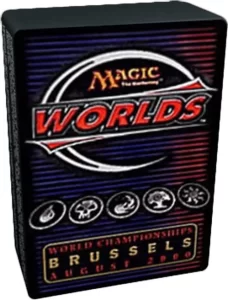

Janosch Kuhn’s 2000 quarterfinalist deck ramps in the early game, then start locking down opponents with land destruction effects.
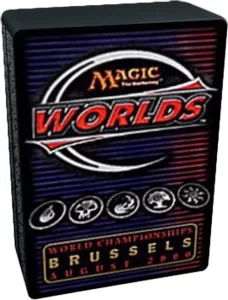

The land removal was essential in this format, as Nicolas Labarre’s combo deck generates infinite mana with Ashnod's Altar, Saproling Cluster, and Fecundity to ramp into Blaze in a sort of proto-elfball strategy.
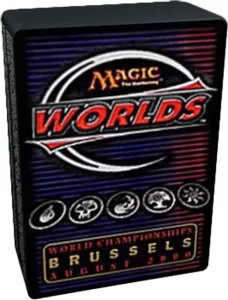

The oddball of its year, Tom van de Logt’s ran a graveyard strategy that loots quickly through the deck with Frantic Search and Attunement, then returns all of its enchantments at once with Replenish. This deck runs no creatures, making its Wrath of God doubly effective.
#2. 1998
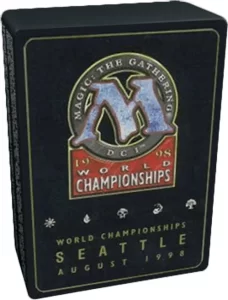

Brian Selden’s 1998 World Champion deck is a combo deck making use of Survival of the Fittest and Recurring Nightmare to tutor up creatures, put them in the graveyard, then sneak them into play. Thankfully, this brutal combo’s payoffs are just Verdant Force and Spirit of the Night, nothing compared to, say, an Unburial Rites’d Griselbrand. It’s still a nasty trick for its time.
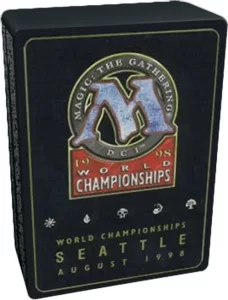

Selden faced Ben Rubin’s “Sligh” deck, a mono-red aggro deck that plays for the most advantage each turn. Jackal Pup, Ball Lightning, and Mogg Flunkies are especially threatening when played sequentially.
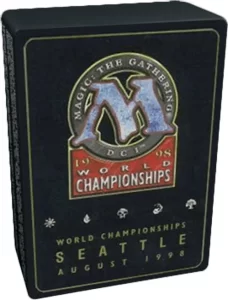

Quarterfinalist Brian Hacker debuted a white weenie deck, running a metric ton of two-drop creatures with shadow, protection, or some other utility. Its Cataclysm is really its only removal, but this deck is sure to win the race to rebuild after the board wipe.
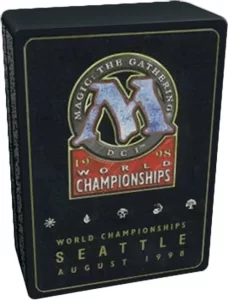

Randy Buehler’s 12th place “Draw, Go” deck is the infuriating control deck with hardly a wincon in sight. Instead, it plays an annoyingly defensive game and hopes to use Rainbow Efreet or Stalking Stones after outlasting its opponent. This is the weakest deck from 1998 and probably the least fun to play and play against of the entire lot. To add insult to injury, Randy’s last name is misspelled on the deck box as “Buelher” and the deck is listed as “twelveth” place.
#1. 1997
1997’s finalists featured two aggro decks and two control decks.

Jakub Slemr became World Champion in 1997 with his Prismatic Black Aggro deck. Four copies each of Black Knight, Fallen Askari, and Knight of Stromgald give this deck a threatening turn two. Three City of Brass help this deck splash into all five colors to speed up the kill. Shadow Guildmage and Man-o'-War can bounce the Nekrataals for another removal spell, and the amorous Uktabi Orangutan destroys the Winter Orbs in the meta.

Slemr’s face-off against Janosch Kuhn’s Jeskai control deck is sure to be a close game. Kuhn’s speed-control deck plays a balance between aggressive attacking with Frenetic Efreet and Wildfire Emissary and locking out its opponents with any of its 30 different removal spells.
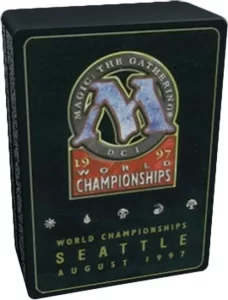

Paul McCabe’s Izzet control deck plays similarly, with more aggro elements in place of Kuhn’s white control cards.

Svend Geertsen’s mono-green stompy deck runs a simple, creature-heavy strategy with only a handful of noncreature spells exclusively to buff attackers.
All in all, 97’s World Championship decks are simple, but fun. They share a lot of cards, especially in their sideboards, but the entire card pool was smaller back then.
Does MTG Still Make World Championship Decks?
Magic no longer produces World Championship Decks. The last four World Championship Decks were released in 2004.
Why Were World Championship Decks Discontinued?
World Championship Decks were discontinued for much the same reason as any of your other favorite niche Magic products were discontinued. Other products simply forced them out of the market. In 2005, Assistant Brand Manager Jake Theis said that WotC wanted a “full product offering for our fans,” but, “the increased popularity of the Fat Pack seems to have gobbled up the demand for a fourth Magic product.” The other three Magic products at the time were Boosters, Tournament Packs, and Theme Decks.
What Was the MSRP of World Championship Decks?
The original MSRP of a World Championship Deck in 1997 was surprisingly affordable at $9.95. Times must’ve gotten tough around the turn of the century for WotC because in 2000 they raised the price to $9.99.
World Championship Decks vs. Starter Decks
World Championship Decks were not the same as the starter “Theme” decks released alongside each new set in the 90s and early 2000s. Where the World Championship decks showcased the strongest strategies and combos from that season, Theme decks and their successors (Starter packs, Guild Kits, Planeswalker Decks, etc.) usually revolve around a specific set’s mechanics and act as an introductory product more than anything else.
That might sound like you would always purchase a World Champs deck over another precon product. Remember that the World Championship Decks are gold-bordered and have a non-standard card back, making them illegal for use in DCI-sanctioned events.
Where Can You Get Old World Championship Decks?
Sealed World Championship Decks are hard to come by, but some online retailers still have some stock. Be ready to pay quite a bit depending on the deck’s power level, though. John Finkel’s 2000 deck goes for $600 on Amazon. Some, like Jakub Slemr’s ‘97 deck, come as low as $80 on TCGPlayer (sorry, Jakub).
You can also purchase the singles and rebuild these decks from scratch. They vary in price depending on the availability and number of reprints their contents have received. If your only goal is to recreate these classic decks mechanically, this is probably the cheapest option.
Are World Championship Decks Legal?
No! Cards from the World Championships Decks series are printed with a gold border and unique card back, making them illegal for use in DCI-sanctioned events. Some consider them “sleeve-playable,” so they make fair alternatives for expensive cards in casual games.
To Be the Very Best
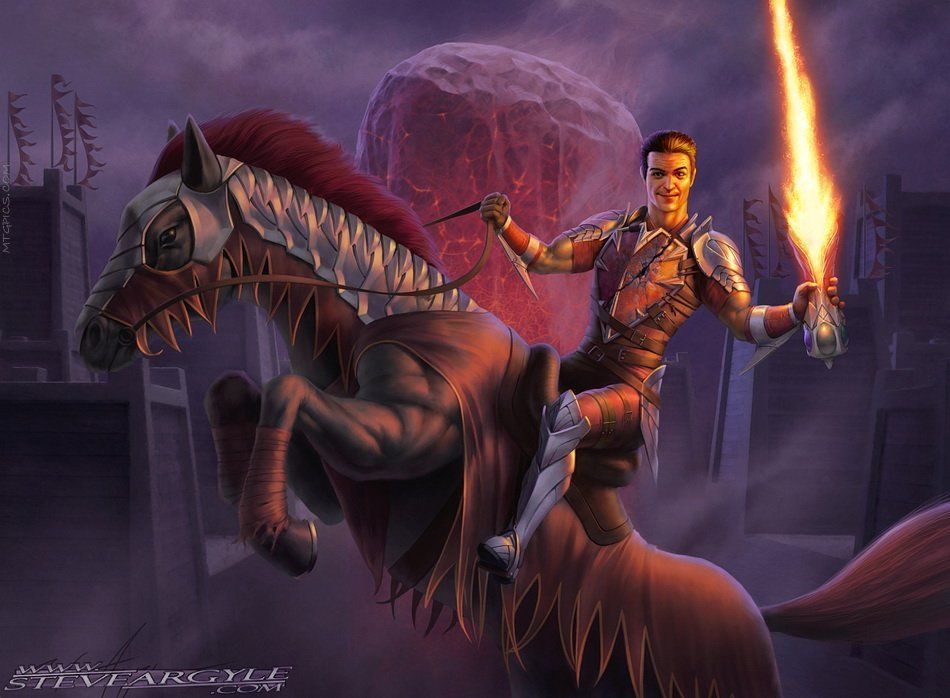

Fervent Champion | Illustration by Steve Argyle
Magic immortalized the World Championships decks forever with this deck series. There’ll always be a record of what the best competitive Magic looked like, and players will even be able to emulate it whenever they want. It’s been almost two decades since their last printing, but I’d love to see this or a similar product return in the years to come.
What’s your favorite World Championship Deck series? Which year’s tournament would you like to replay? Do you let your opponents use gold-bordered cards in your games? Let us know in the comments, or over on Draftsim’s Twitter.
Thanks for reading, I’ll see you on the Pro Tour!
Note: this post contains affiliate links. If you use these links to make a purchase, you’ll help Draftsim continue to provide awesome free articles and apps.
Follow Draftsim for awesome articles and set updates:


Add Comment